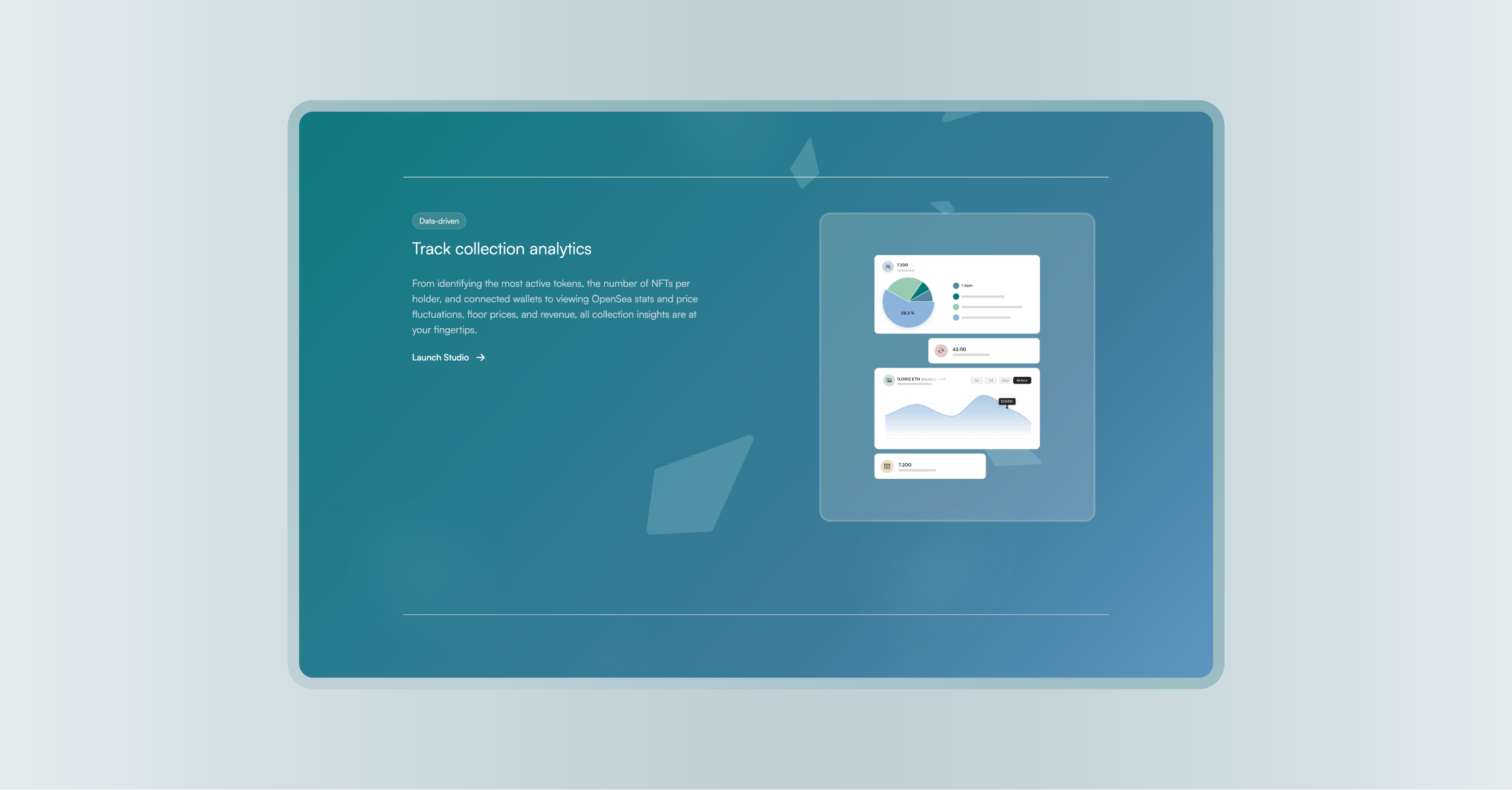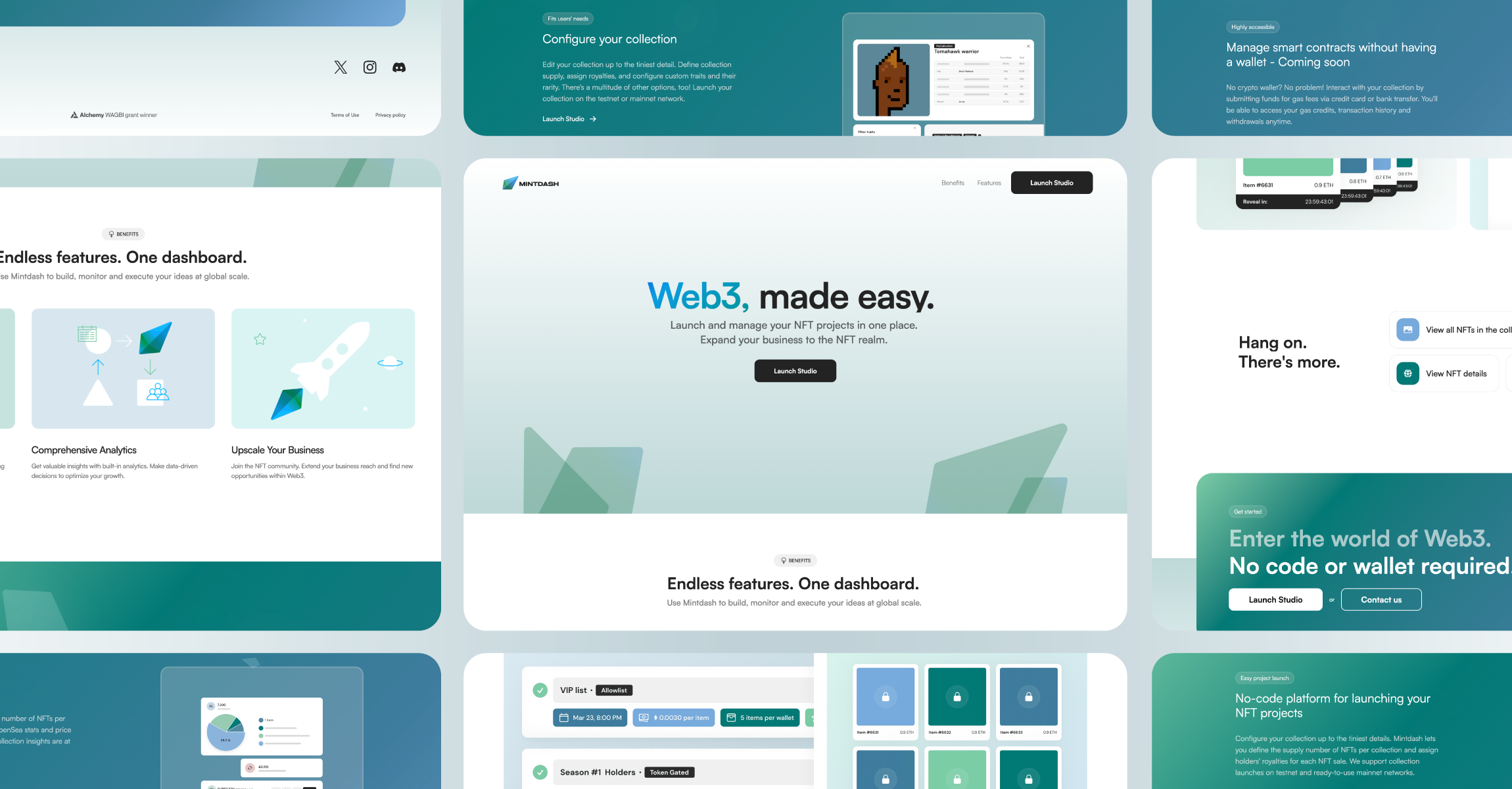Mintdash: Web3, made easy.
Mintadash is a no-code platform for launching and managing NFT projects that can help businesses and individuals successfully expand their work to the Web3 space.
Design
- Research
- UX design
- UI design
- Prototyping and testing
Development
- Frontend development
- Backend development
- Smart contract development
Quality Asurance
- Functional testing
- Monitoring
Following the rise in popularity of NFTs and Web3, there’s a huge increase in the communities that are looking to join the digital revolution with their own personalized NFT products and services.
Mintdash, a no-code platform for launching and managing NFT projects, is our contribution to the Web3 community. It can help businesses and individuals successfully expand their work to the Web3 space.
This is our in-house platform that we’ve designed and implemented from the ground up. The project consists of two main parts, the dashboard for managing NFT projects and a landing page that promotes the platform, showcasing the main features.
About Mintdash
Mintdash is a user-friendly platform that supports simplified NFT project management, backed by comprehensive analytics and valuable insights, with a mission to promote the NFT community and help teams find new opportunities within the Web3 domain.
First, it lets you configure and generate your collection. We built an intuitive dashboard where you can, in only a few clicks, choose the type of smart contract you want to use and configure it. You can use the dashboard to define max supply of your collection, define the metadata base URL for the collection, set the payout address and follow the collection balance, make an airdrop, set royalties settings, customize your minting schedule, and token-gate your content. Mintdash is a multi-chain platform, that allows you to generate a collection across different chains easily.
Of course, it would be impossible to manage a successful collection without having an insight into its analytics. You can use the dashboard to see all analytics and activities related to your collection. What’s more, it’s possible to track info about the holders, minted NFTs, sales and profit, most active tokens, and even OpenSea statistics.
Finally, Mintdash allows you to launch your custom NFT minting page with a single click.
Different Collection Types
On Mintdash, you can create different collection types for your NFT projects: collection drops, editions, or unique NFT mints. Each collection type is powered by audited, extensible smart contracts that follow the latest standards.
You can create an unlimited number of NFT collections for your community to mint. Supported collection types are:
- Collection Drop (ERC-721): Create a collection of NFTs for community minting.
- Collection Editions (ERC-1155): Offer multiple editions of the same artwork.
- Unique Mints (ERC-721): Create and mint an NFT directly to your wallet.
- Soulbound Collection Drop (ERC-721): Establish a collection of NFTs that can't be transferred after minting.
- Soulbound Collection Editions (ERC-1155): Provide multiple editions of the same artwork that can't be transferred after minting.
Custom Mint Pages
Custom mint pages allow you to quickly create a production-ready website for your collection. Add basic information, upload a profile and cover image, and describe your collection to the world. You can also add your team members, project roadmap, and frequently asked questions in just a few clicks.
Custom mint pages are deployed on a separate subdomain, and their visibility is controlled by you.
Metadata Management
You can easily manage metadata for your NFT collection through Mintdash. Metadata management allows you to upload assets and metadata files for Mintdash to serve to your collectors.
You can set up metadata reveal strategies. Metadata can be revealed as soon as a user mints an NFT, or it can be revealed later whenever you choose.
Mintdash takes care of protecting and serving your NFT metadata. If you want, you can set up metadata to be served from your website but still rely on Mintdash to protect your metadata for NFTs that are not yet minted.
Gas Sponsorship
You can set up your collection mint to be free for users, with gas fees sponsored by you. Mintdash will create a system wallet for you to fund. Funds will cover gas fees for your users. Gas sponsorship can be configured per mint phase, giving you the flexibility to set up your mint drop in different ways.
Easily set up gas sponsorship for your collection and allow users to collect your NFTs without having any funds in their wallets. You can also use the Mintdash API to mint NFTs for users.
User flow
We know Web3 is expanding to new industries and we want Mintdash to be accessible to anyone, despite their background. You don’t need to be tech-savvy to launch an NFT project.
Here’s how Mintdash works! After you enter the collection data and confirm the transaction with your wallet, our backend deploys the contract to the blockchain. Best of all, it only takes a few minutes. Collection data is saved in our databases.
After the deployment, you can configure your collection. The indexer is constantly listening to collection-related events and saves activities to a database. Based on this activity, we show the analytics on the frontend, for you to see it!
Design
So, what does it take to build such a platform? First, our design team rolled up their sleeves and delivered a clean, user-friendly dashboard. Here’s a quick overview of the Mintdash design process.
Research
We had to define the goals, research the competition, and figure out a way to stand out with better features and better UX. To define basic features, we outlined the main tasks Mintdash users should be able to complete on the dashboard. Then, we composed a user journey that effortlessly solves their problems and helps us achieve set goals.
We created a mind map of all the screens and connected them to define an information architecture. Then, we arranged content for each screen to make sure that all the necessary information was easy to reach and navigation was simple.
Prototyping and testing
We designed low-fidelity prototypes to test our findings from the research phase of the process and arranged all the elements screens should have. With finished wireframes, we came up with prototypes and tested if all the use cases were covered and the user flow was polished.
User interface
The user interface was designed with one idea in mind. We had to make it simple and approachable, without any distractions, so all information would be easily accessible. Since Mintdash is our in-house project, we combined shades of green and blue from our Blank branding to highlight the most important UI elements.
We expect this product to grow and evolve, so we defined a design system that would be easy to maintain and support dark and light modes. We used components and styles so iterations could be quick. Even though we’re building an admin dashboard that is rarely responsive, we wanted to support that option, too, in case our users decide to access Mintdash from their mobile devices.
Mintdash is a product that will be expanded and we’re already considering new features and improvements, so we repeated all these steps many times.
Development
After the design was ready, our developers hopped on the project and did their magic! Let us walk you through the most crucial steps of the Mintdash development process.
Research
We already stated that Mintdash is a brand-new product and we’re developing it in-house, so our developers had to an extensive research, too, before they started coding.
We wanted to challenge ourselves and find the best possible way to implement each new feature and figure out the requirements to achieve it. So, before adding new features, we would research the technology and conduct market research. What’s more, during the development itself, we faced frequent changes in the specifications.
After all, we had to make sure everything was flawless!
Backend and smart contracts
We strive to provide users with a fast and simple way to create their own Web3 application. Accordingly, Mintdash’s backend has to be safe and stable because we use it to create smart contracts. To achieve this we used Nest JS.
Webhooks
Webhooks allow you to register endpoints for Mintdash to call when events happen with your collection. For example, this allows you to harness the power of our indexers to execute custom logic when NFTs are minted.
Whitelabel-ready
Our solution is whitelabel-ready, which means we can deploy a complete studio for your project with your fonts, colors, and themes. We handle hosting, maintenance, and the addition of new features.
Our whitelabel solution can save you enormous amounts of time and money if you want to build an NFT launchpad and creator studio solution for your product.
Testing
The last step is thorough testing, both manual and program, to make sure that the application works seamlessly.
Tech stack
This is a complex dashboard so our tech stack is pretty rich! It was designed in Figma, and in the development phase, we worked with NextJS and Tailwind on the front-end, NestJS on the back end, PostgreSQL for the database, and Solidity to develop smart contracts. We used the Subsquid indexer to listen to events on the blockchain network and collect data based on those events. We used this data to show analytics, activity, holder lists, and so on.
Mintdash is a web application only, not mobile, but it’s possible to access it from any mobile browser.
Additionally, we designed and implemented a landing page that would showcase the most important features and present Mintdash to all potential users.
Launch your project with Blank
Do you have a project in mind that you would like to turn into reality? Mintdash is an amazing platform that will help you launch NFT projects in a few quick steps.
However, you can reach us directly to discuss any project, anytime. We specialize in building digital solutions for our clients all around the globe. Simply visit our contact page and tell us what you need.
We look forward to hearing from you!






